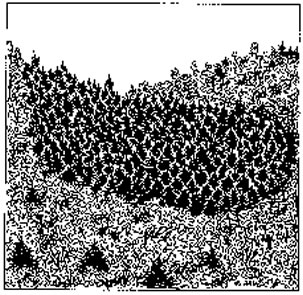Recommended Voluntary Forest Management Practices for New Hampshire
6.4 OVERSTORY INCLUSIONS
BACKGROUND
Maintaining or creating inclusions of overstory that are distinct from the surrounding forest type can greatly increase the habitat diversity of otherwise uniform areas.
 Overstory inclusions are small patches of forest distinct from the surrounding forest but too small to be mapped or treated separately. A patch of hemlock in a pure hardwood stand, or patches of oak in a pine stand would qualify as examples of overstory inclusions.
Overstory inclusions are small patches of forest distinct from the surrounding forest but too small to be mapped or treated separately. A patch of hemlock in a pure hardwood stand, or patches of oak in a pine stand would qualify as examples of overstory inclusions.
Inclusions provide feeding, nesting, and shelter that may not occur in continuous stands of a single forest type. More than 25 percent of New England's bird species and a lesser number of mammals use overstory inclusions in one way or another. Deer, moose and some furbearers are attracted to softwood inclusions within hardwood stands. Such inclusions may be important for facilitating movement of these animals during deep snow conditions.
Inclusions may range in size from just a few trees to more than an acre. The value of a minor inclusion increases in proportion to how different it is from the surrounding forest. Even a single softwood tree such as a hemlock, large-crowned spruce, or a large white pine within a pure hardwood stand, can greatly increase the variety of available habitats.
OBJECTIVE
Maintain and regenerate inclusions of softwood cover in predominantly hardwood stands and inclusions of hardwood cover in predominantly softwood stands.
CONSIDERATIONS
- Applying different treatments to small inclusions may be uneconomical if these treatments require different equipment or techniques.
- Small volumes of some species derived from harvesting inclusions may not be marketable.
- Removing surrounding cover may put inclusions at risk of blowdown, sunscald, and other damage.
- Inclusions may result from either small-scale site differences or variations in the past disturbances of a stand. Natural succession may work against the maintenance of these areas, especially if advanced regeneration of the surrounding dominant vegetation is present. Maintenance and regeneration of inclusions will be more practical where inclusions result from relatively permanent site factors, rather than from variations in disturbance history across a uniform site.
RECOMMENDED PRACTICES
- Create inclusions in large uniform stands if site conditions allow.
- Where inclusions exist, develop prescriptions to maintain or regenerate them in their current type. Inclusions shouldn't necessarily receive the same prescription as the rest of the stand.
- Leave inclusions unharvested if the inclusion is:
- Relatively unique to the area.
- Small (one-quarter acre or less) and the volume of timber generated from its treatment will be limited.
- From small-scale differences in site conditions that may be sensitive to disturbance (such as wet areas or shallow soils over ledge).
- Leave a buffer around softwood inclusions to provide wind protection. The buffer should be at least 2 to 3 tree-heights wide on the side exposed to prevailing winds. Don't remove more than 25 percent of the basal area within this buffer.
- Inclusions can often be incorporated with other desired habitat features such as a seep, vernal pool, or a large legacy tree.
- On larger ownerships, locate and map inclusions (e.g., with a GPS) for monitoring purposes.
CROSS REFERENCES
6.1 Mast; 6.7 Aspen Management; 6.9 Deer Wintering Areas; 7.2 Seeps; 7.3 Vernal Pools.
ADDITIONAL INFORMATION
DeGraaf, R., M. Yamasaki, W. B. Leak, and A. M. Lester. 2006. Technical Guide to Forest Wildlife Habitat Management in New England. University of Vermont Press and University Press of New England, Burlington, Vt. 305 p.
Hunter, M.L., Jr.1990. Wildlife, Forests and Forestry: Principles of Managing Forests for Biological Diversity. Prentice-Hall, New York, N.Y. 370 p.